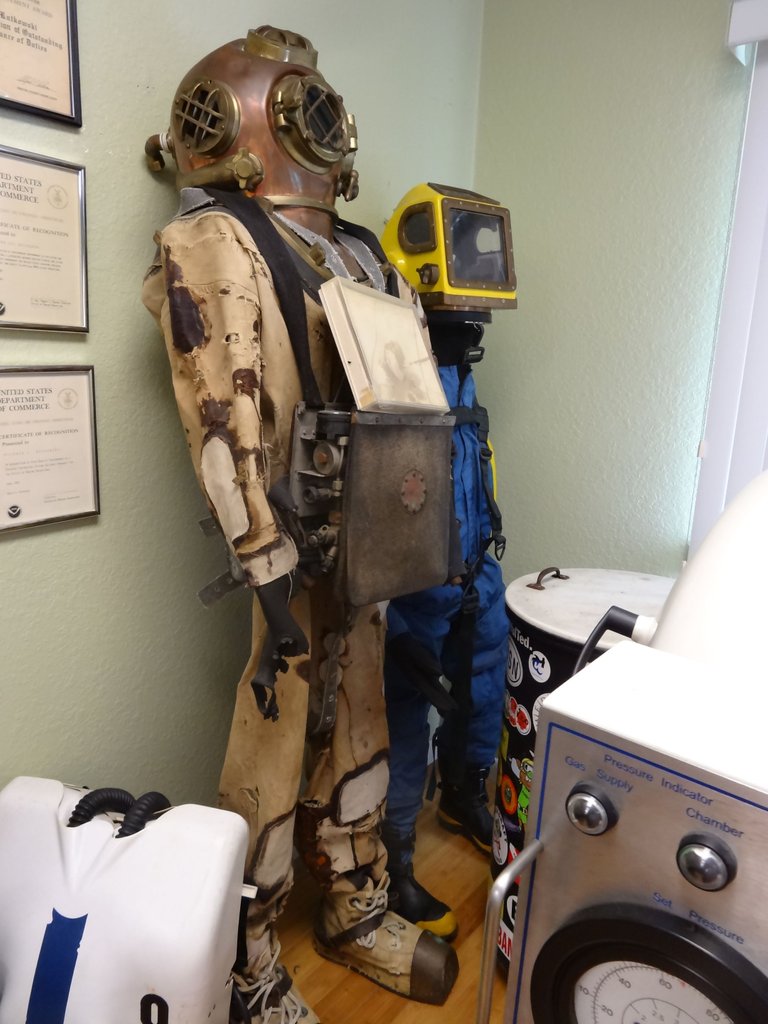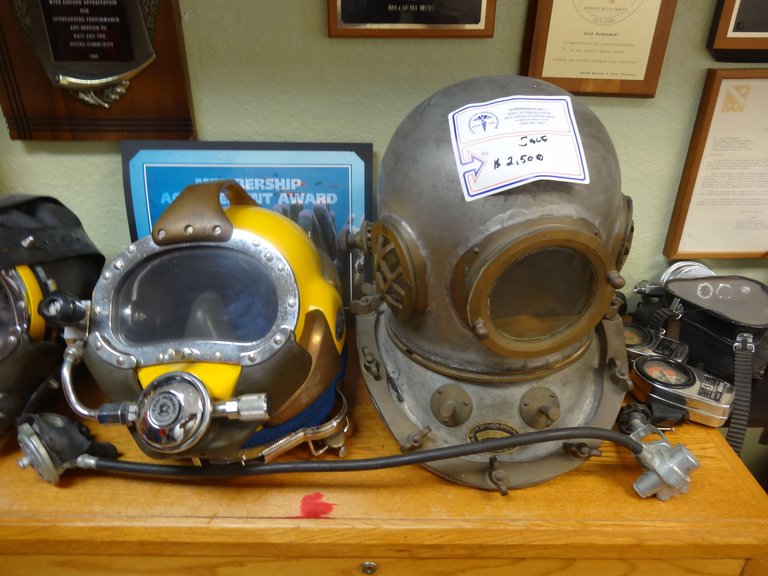The diving helmet from the film “Men of Honor”
A photo that, when I took it, made me relive the history of diving, and remember one of my most precious films.
Hello, to all of you who visit this community, which I perceive to be somewhat dormant, but very interesting.
Today I am sending you my first post in it. I will feel satisfied, if even one person reads it.
On a cool afternoon in July 2016, I was presented with the certificate of completion of the Advance Diving and Hyperbaric Medical Team Training Program, at Hyperbarics International in Key Largo, FL. United States.
These were moments I will never forget as I was able to receive instruction from a very well known instructor for his expertise in commercial diving and breathing gas mixing, Dr. Dick Rutkowski.
They shared the training, doctors and medical personnel of the US Navy, where we achieved a very nice affinity during those days.
This place had a small museum on its right side wall, where some vintage diving equipment was exhibited and sold.
At the beginning of the course, an outline of the history of diving is made; and something very interesting, and that I personally like a lot, is related to the classic Siebe Gorman diving helmet.
Diving equipment, from before 1800 to date, has also evolved. From flexible to rigid equipment, open and closed circuit autonomous equipment, umbilical bells, to the most sophisticated equipment such as robots, bathyscaphs and submarines. All of them follow a growing line of development.
But the protagonist of this post is the famous classic scuba diving suit and I want to comment on it.
It was designed by Siebe Gorman in 1837, so that the diver could protect himself from the low temperatures of the aquatic environment and avoid hypothermia, as well as accidents due to cuts and mechanical friction.
The diver, with the help of other people, is introduced standing up in the suit, by his neck. From the surface, air is pumped to the diver through the supply hoses.
What are the parts of this scuba suit?
- Diving Helmet:
Made of copper or other metals, with a thickness of 1 to 1.5 cm. Its function is to protect the diver's head, and is the reservoir of the breathing mixture. At the top, it has a handle to raise it in case it is required.
It has 3 illuminators or windows for lateral and frontal vision. The hoses coming from the outside are connected to a non-return valve that provides air. The air outlet is on the other side.
The exhaust valve is responsible for maintaining the desired buoyancy, which is controlled by head movements. It also receives the communication with the tender, which guides it from the outside.
It is fixed to the suit for more security, through 12 bolts.
- Base:
Formed by a thick part, which couples to the helmet with a rubber gasket. It maintains the tightness of the head with the scuba diving suit. In the front and back part there are the lead hangers, and it has 2 lateral safety hooks.
- Diving suit:
It is incompressible and thick, being made of 3 to 5 rubber plates. It is watertight from head to neck. Some models are open at the wrists, with a watertight system.
It has 2 valves to allow the exit of air to the outside, a front mechanical valve and a rear valve that operates automatically, which are used to prevent increases in the gaseous volume inside.
- Diver boots:
They are of great weight due to the metal parts it has. Its function is that the diver achieves the vertical position at the bottom. These weights must be well fastened to avoid imbalances.
- Weights:
An anterior and a posterior weight is used. The air reaches the suit up to chest level, achieving a negative buoyancy so that the diver maintains an upright position and can walk on the bottom.
- Hoses:
They are multi-layered, to withstand high ambient pressure. Some of them, with steel springs inside, for more resistance of the material.
By these, the diver can be rescued, in case of fracture of the guide.
The person descends and rises normally to the surface in a basket, and in an emergency, is that it is raised through the guide or hoses.
- Safety rope or guide:
It gives us the location of the diver and serves to rescue him.
It is attached at waist level. In case it breaks, the diver is raised through the hoses.
- Knife:
Apart from serving in the event of an emergency, it fulfills a certain function as a weight balancer.
Well Hivers, now that you have an idea of the parts of the Siebe Gorman scuba diving suit, you can imagine all the weight that these diving professionals must mobilize. Those who are subjected to limited movements, low temperatures, and exposed to dysbaric diseases, which can cause disabling sequelae or even death.
All of this is well detailed in the award-winning 2000 film Men of Honor, starring Robert De Niro and Cuba Gooding, Jr.
Based on the true life story of Carl Brashear, the first African-American dive master and senior chief of the United States Navy. Who was able to follow with total focus, discipline and iron will, the dream of being a certified diver at that level, even with the limitation of having lost part of his left leg in a work mission.
A story that has been able to inspire many diving lovers, which was taken to the screen of the Seventh Art, and where the diving suit used was a classic Siebe Gorman type diving suit. The one that today is a vintage collection equipment, for those passionate about the history of diving, where the helmet will be the most desired part.
The photos are of my authorship. I relied on information from my notes, during my master's degree in my medical specialty.
Carl's few details are described in the final part of the film Man of Honor.
Thank you for reading
Welcome your comments
Infinite greetings!


https://twitter.com/AndresBrunetMD/status/1564700387436904449
The rewards earned on this comment will go directly to the people sharing the post on Twitter as long as they are registered with @poshtoken. Sign up at https://hiveposh.com.
@tipu curate
Upvoted 👌 (Mana: 0/32) Liquid rewards.